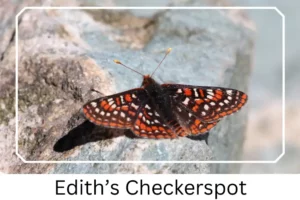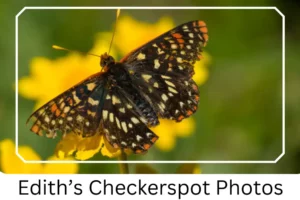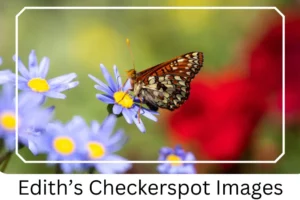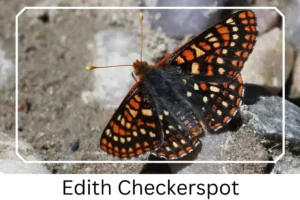Edith’s Checkerspot (Euphydryas editha)
The Edith’s Checkerspot is a captivating species belonging to the Nymphalidae family, predominantly found in the western regions of North America. This butterfly is celebrated for its striking patterns and colors but faces threats from habitat destruction and climate change, leading to a decline in some subspecies.
Scientific Classification
- Family: Nymphalidae
- Genus: Euphydryas
- Scientific Name: Euphydryas editha
Overview
Edith’s Checkerspot butterflies are a study in resilience and beauty. They inhabit diverse environments, from coastal areas to mountainous terrains, adapting remarkably to their surroundings. Despite their adaptability, they are not immune to the broader environmental challenges that threaten their survival, such as climate change and habitat loss. This article explores their lifecycle, from the distinctive caterpillar stage to the vibrant adult phase, highlighting their ecological importance and the conservation efforts required to protect them.
Description and Identification
Caterpillar
The larval stage of Edith’s Checkerspot presents a striking appearance, with a black body adorned with orange or white spots, or white stripes, preparing it for a remarkable transformation.
Pupa
Transitioning into the pupa stage, these creatures develop a white or grey body, accentuated with black streaks and blotches, signaling the impending emergence of the adult butterfly.
Adult Butterfly
Sexual Dimorphism: Currently unknown, indicating a fascinating area for further research.
Color and Appearance: The adult butterfly displays a mesmerizing array of colors. When the wings are opened, a canvas of black with bands of orange, red, cream, and yellow unfolds. In contrast, the closed wing view reveals a checkered pattern of orange and white. The specific hues and patterns vary slightly by region, with coastal dwellers featuring cream and red spots against a black background, while mountain inhabitants boast a mottled or red body speckled with cream, red, and black.
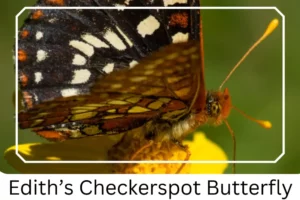
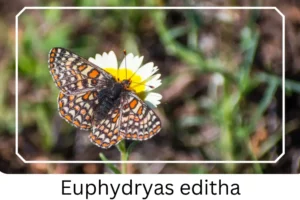 Average Wingspan: Ranges from 3.2 cm to 5.1 cm (1.25 – 2.0 in), showcasing the butterfly’s delicate yet robust structure.
Average Wingspan: Ranges from 3.2 cm to 5.1 cm (1.25 – 2.0 in), showcasing the butterfly’s delicate yet robust structure.
Flight Pattern: Characterized as fast, reflecting their agile and dynamic nature in navigating their habitat.
Eggs
The beginning of the lifecycle, the eggs are mostly pale green and are laid on host plants in clusters ranging from 20 to 350, ensuring the continuation of their species.
Quick Facts | |
| Distribution | Across various North American regions, including British Columbia, Nevada, Baja California, Colorado, and Utah. |
| Habitat | Prefers mountains, open woodlands, and alpine tundra. |
| Lifespan of Adults | Approximately ten days. |
| Host Plants | Utilizes Plantain, Owl’s Clover, Indian paintbrush, Lousewort, and Penstemon. |
| Adult Diet | Primarily nectar from flowers. |
How to Identify Edith’s Checkerspot?
Identifying Edith’s Checkerspot butterflies involves looking for their distinctive patterns and colors. The caterpillars are easily recognizable by their black bodies with orange or white markings. As they transform into pupae, the appearance shifts to a grey or white body with black blotches. Adult butterflies are most notable for their checkered wing patterns when closed, and the vibrant bands of color when opened. Observing their flight patterns, which are notably swift, can also aid in identification. Furthermore, their presence in specific habitats such as mountains, open woodlands, and alpine tundra, coupled with their unique host plants, including Plantain and Indian paintbrush, provides clues to their identification.
Did You Know?
- Climate change and global warming have significantly impacted several subspecies of Edith’s Checkerspot, particularly the Euphydryas Editha bayensis and Euphydryas Editha quino, which are now protected under the Endangered Species Act.
- This butterfly species can lay up to 350 eggs at a time, showcasing a remarkable reproductive strategy to ensure their survival against environmental threats.
- The variation in color and pattern among individuals based on their habitat highlights the butterfly’s adaptability and the influence of environmental factors on its development.
Conclusion
Edith’s Checkerspot butterflies encapsulate the beauty and complexity of nature’s creations. Their lifecycle, from the visually striking caterpillar to the vibrant adult butterfly, offers a glimpse into the wonders of metamorphosis. However, their existence is threatened by the very environment they are adapted to, with climate change posing a significant risk. Protecting these butterflies requires a concerted effort to mitigate environmental impacts and preserve their natural habitats, ensuring the survival of this remarkable species for generations to come.

